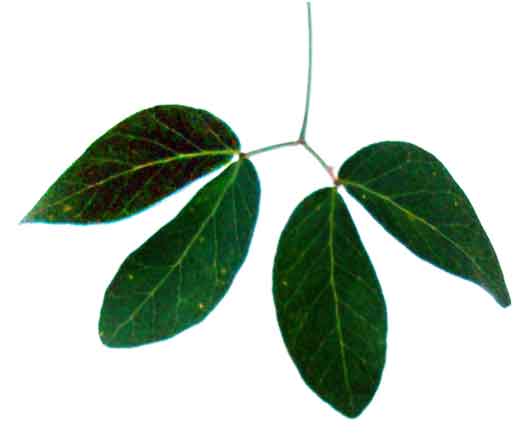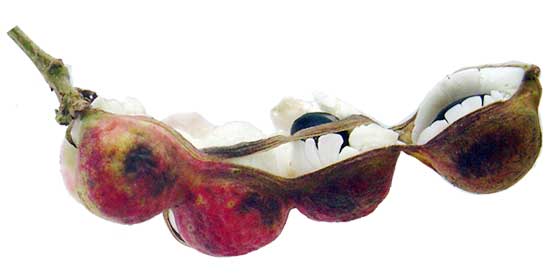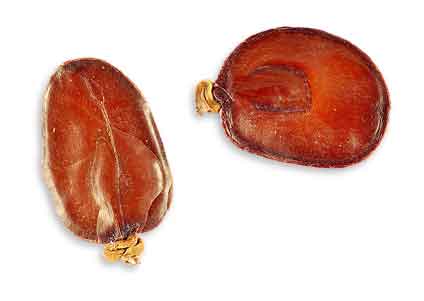Gen info
- Referred to as Manila tamarind because of the sweet-sour tamarind-like taste.
- Etymology:
Genus Pithecellobium derives from from the Greek words 'pithekos' (ape) and 'lobos' (pod), and the species name 'dulce' from the Latin 'dulcis' meaning sweet.
 Botany
Botany
Kamatsile is a tree 5 to 18 meters
high, with pendulous branches, with short, sharp stipular spines.
The leaves are evenly 2-pinnate, 4 to 8 centimeters long. The flowers
are white, in dense heads, 1 centimeter in diameter. Pods are turgid,
twisted, and spiral, 10 to 18 centimeters long, 1 centimeter wide, and dehiscent
along the lower suture. Seeds are 6 to 8, with an edible, whitish,
pulpy aril. The arillus is sweet when the fruit is ripe.
Distribution
Found throughout the
Philippines at low or medium altitudes.
Constituents
- Tannin, 25.36%; fixed
oil, 18.22%, olein.
- A glycoside quercitin has been isolated.
- Seeds have been reported to contain steroids, saponins, lipids, phospholipids,
glycosides, glycolipids and polysaccharides.
- Bark yields 37% tannins of the catechol type.
- Leaves yield quercitin, kaempferol, dulcitol and afezilin.
- Fatty acid analysis of seed extract yielded 9 saturated and 17 unsaturated fatty acids. Elemental composition yielded (mg/kg) arsenic 17.6µg/kg, copper 16.25, cadmium 3.48, iron 1.89, lead 0.19, magnesium 15.06, potassium 26.89, sodium 10.19, zinc 26.89.
Total protein content was highest in the seeds (50.3-67.1%), followed by stems, roots, leaves, flowers, and fruits. (21)
- Ethanolic extract of fruits yielded ten compounds viz. (1) 2, 5, 6-trimethyl 1, 3-oxathiane, (2) trans-3-methyl-2-N-propylthiophane, (3) 2-furan carboxaldehyde-5-(hydroxymethyl), (4) D-pinitol, (5) heptacosanoic acid, (6) hexadecanoic acid, (7) tetracosanol, (8) 22-tricosenoic acid, (9) methyl-2-hydroxy icosanoate and (10) stigmasterol. (25)
- Evaluation of seed protein flour showed a protein content of 39.22%, calcium 48 mg, and phosphorus 542 mg/100 g. Major amino acids were glutamic acid, arginine, aspartic acid, lysine, valine, threonine and leucine. Ratio of essential to nonessential amino acid was 0.61. Total polyphenol content was 294 mg/100g. (31)
- GC-MS study of leaves yielded bioactive constituents: phytol, anthracene, 9(3butenyl), diisooctyl phthalate, 13-docosenamide, 3,6,9-triethyl3,6,9trimethyl formic acid, cyclotetrasiloxane, octamethyl, l(+) ascorbic acid 2,6dihexadecanoate. (see study below) (33)
- GC-MS analysis of fruit peel extract yielded 36 bioactive compounds with pinnitol, L-rhamnose and 1,5-anhydro-6-deoxyhexo-2,3-diulose as dominant compounds. (see study below) (43)
- Study of seeds of Pithecellobium dulce seeds yielded seven saponins, oleanane glycosides Pithedulosides A-G. (51)
Properties
- Considered abortifacient,
anodyne, astringent, larvicidal, antibacterial, anti-inflammatory,
febrifuge, antidiabetic.
- Bark and leaves considered astringent.
- Leaves considered astringent, emollient, antidiabetic, and abortifacient.
- Roots reported to be estrogenic.
- Studies have suggested antidiabetic, hypolipidemic, anti-inflammatory, antioxidant, antibacterial, antifungal, antimutagenic, antituberculosis, antiulcerogenic, renoprotective, hepatoprotective, CNS depressant, larvicidal, anthelmintic, analgesic, antidiarrheal, cardioprotecitve, anticancer properties.

Parts used
Bark, leaves.
Uses
Edibility
- Pulp around the seed
is edible.
Folkloric
• Frequent bowel
movements: Decoction of bark taken as tea.
• The leaves, when applied as plasters, used for pain, venereal
sores.
• Salted decoction of leaves, for indigestion; also used as
abortifacient.
• Bark used in dysentery, dermatitis and eye inflammation.
• In Brazil, used
as a cancer elixir.
• In Mexico, decoction of leaves for earaches, leprosy, toothaches
and larvicide.
• In India, bark of the plant used as astringent in dysentery, febrifuge. Also used for dermatitis and eye inflammations. Leaves used as abortifacient.
• In Guiana, root bark used for dysentery and as febrifuge.
 Studies
Studies
• Anti-Inflammatory / Antibacterial / Quercetin / Flowers: Study of the fresh flowers of Pithecellobium dulce
yielded a glycoside quercitin. The activity of the flavonol glycoside confirmed its anti-inflammatory and
antibacterial properties. (1)
• Phenolics / Antioxidant: Study
of the aqueous extract of Pithecellobium dulce leaves revealed phenolics
including flavonoids and showed potent free radical scavenging activity. (2)
• Anti-inflammatory Triterpene: Anti-inflammatory triterpene saponins of Pithecellobium dulce:
characterization of an echinocystic acid bisdesmoside. A new bisdesmodic
triterpenoid saponin, dulcin, was isolated from the seeds of PD. (3)
• Genotoxicity / Mutagenic and Antimutagenic Activities: In a study of 138 medicinal plants for genotoxicity,
Pithecellobium dulce was one of 12 that exhibited detectable genotoxicity in any system. (4)
• Anti-tuberculosis / Antimicrobial: Hexane, chloroform and alcoholic leaf extracts were studied for activity against Mycobacterium tuberculosis strains. The alcoholic extract showed good inhibitory activity and antimicrobial activity against secondary pathogens. (6)
• Anti-Diabetic / Leaves: Study of ethanolic and aqueous leaf extract of P dulce in STZ-induced diabetic model in rats showed significant activity, aqueous more than the alcoholic extract, comparable to glibenclamide. (7)
• Anti-Ulcer / Free Radical Scavenging: Study of the hydroalcoholic extract of PD was found to possess good antioxidant activity and suggests possible antiulcer activity with its free-radical scavenging and inhibition of H, K-ATPase activities comparable to omeprazole. Phytochemical screening yielded flavonoids - quercetin, rutin, kaempferol, naringin, daidzein. (8)
• Hepatoprotective / Carbon Tetrachloride Induced Toxicity: Study of an aqueous extract of P. dulce in a murine model showed hepatoprotection against CCl4-induced oxidative impairments probably through its antioxidative property. Results were supported by histological findings. (9)
• CNS Depressant: Study evaluating the locomotor activity of aqueous and alcoholic extracts of PD in albino mice showed significant CNS depression, the alcoholic extract exhibiting greater effect when compared to chlorpromazine. The activity was attributed to an increase in the concentration of GABA in the brain. (10)
• Analgesic / Anti-Inflammatory: Study of methanol extract showed significant anti-inflammatory and analgesic effects comparable to standard drugs. (11)
• Antioxidant / Antibacterial: Study of fruit peel for antioxidant and antibacterial potential revealed significant activity in the ethyl acetate, methanolic, and aqueous extracts. (12)
• Acute and Subacute Toxicity Studies / Fruit Extract: Study on albino rats evaluated the acute and subacute toxicity profile of a hydroalcoholic fruit extract of P. dulce. PD did not cause any abnormal changes in hematological and biochemical parameters. Results suggest HAEPD can be used safely for experimental and clinical trials. (13)
• Antioxidant / Free Radical Scavenging: Study evaluated aqueous and methanol extracts of seeds for antioxidant potential. Results showed good dose-dependent free radical scavenging activity in all the models. The activity was attributed to high phenolic contents. (14)
• Hypolipidemic / Free Radical Scavenging: Study evaluated the anti-hyperlipidemic activity of an aqueous extract of leaves against triton induced hyperlipidemia in rats. Results showed lipid effects with a decrease in total serum cholesterol, LDL, and an increase in serum HDL cholesterol level. (15)
• Adulticidal / Free Radical Scavenging: Study evaluated the adulticidal activity of various solvent leaf and seed extracts against Culex quinquefasciatus. Results showed the crude extract of P. dulce has excellent potential for controlling filiariasis vector mosquito Cx quinquefasciatus. (16)
• Antimicrobial / Leaf Extracts: Study evaluated the antimicrobial activity of leaf of P. dulce against 20 pathogenic microorganisms. Results showed extracts possess bioactive compounds with significant antimicrobial activities. (17)
• α-Glucosidase and α-Amylase / Bark and Leaves: Study evaluated bark and leaves of P. dulce forα-amylase and α-glucosidase inhibition in vitro. α-amylase and α-gluscosidase inhibitors from food-grade plant sources offer an alternative approach for the treatment of post-prandial hyperglycemia by decrease glucose release from starch and delaying carbohydrate absorption. Results confirmed α-glucosidase and α-amylase inhibitory activity of a methanol and ethanol extract. (18)
• Skeletal Muscle Relaxant / CNS Depressant / Leaves: Study showed an acutely administered single dose of aqueous and ethanolic extracts of leaves possess skeletal muscle relaxant activity and CNS depressant activity but no anticonvulsant action. (19)
• Larvicidal & Ovicidal Against Mosquito Vectors: Study in Swiss albino mice evaluated various extracts of P. dulce for larvicidal and ovicidal potential against mosquito vectors, Anopheles stephensi and Aedes aegypti. All leaf and seed extracts showed moderate larvicidal and ovicidal effects; however, the methanol extract of leaf showed the highest larval activity. Results suggest the seed and leaf extracts have potential as an eco-friendly option for mosquito vector control. (22)
• Anti-Diabetic / Fruits: Study evaluated the antidiabetic potential of P. dulce fruits in STZ-induced experimental diabetes in rats. Results showed significant reduction in blood glucose, glycosylated hemoglobin, urea and creatinine. There was also improved glycogen contact upon treatment with the extract. (23)
• Cardioprotective / Fruit Peel: Study evaluated the effect of P. dulce peel in isoproterenol (ISO) induced myocardial infarction in adult male Wistar rats. ISO-induced MI in rats showed increase in marker enzymes. Pretreatment PD fruit peel extracts positively altered the activities of marker enzymes and biochemical parameters in ISO-induced rats. (24)
• Anthelmintic / Leaves: Study evaluated leaf extracts of P. dulce in three different concentrations for anthelmintic activity against Pheretima posthuma. The aqueous extract was more potent than the alcoholic extract, with activity comparable to the reference drug piperazine citrate. (26)
• Adulticidal / Aedes aegypti: Study evaluated the toxicity and mosquito adulticidal activity of different solvent leaf and seed extracts of P. dulce against dengue vector, Aedes aegypti. Among tested solvents, the leaf and seed methanol extract showed maximum efficacy. (27)
• Antiulcer / Fruits: Study evaluated the antiulcer activity of hydroalcoholic fruit extract of Pithecellobium dulce on a cysteamine induced duodenal ulcer model in male albino Wistar rats. Rats preadministered with HAEPD showed significantly reduced ulcer score compatible to that of ranitidine pretreated rats. Results showed antioxidant and cytoprotective antiulcer activity. (29)
• Titanium Nanoparticles / Fruits: Study reported on the biosynthesis of titanium dioxide nanoparticles using Pithecellobium dulce and Lagenaria siceraria aqueous leaf extract. The nanoparticles synthesized by biological method showed a higher antioxidant potential and antimicrobial activity than chemically synthesized. (30)
• Polysaccharides / Antioxidant / Seeds: Study secluded water soluble PDP polysaccharides from P. dulce seeds. Fractions were tested for in vitro antioxidant capacities by DPPH, h2O2 and reducing power assay. Results showed activity in a dose dependent manner comparable to standard ascorbic acid. (32)
• Antibacterial / Leaves: The leaf extract of P. dulce showed good inhibition against gram positive organisms. The highest inhibition was noted S. epidermidis (24mm), P. acne (14mm), and S. aureus (11mm). (see study above) (33)
• Antidiarrheal: Study evaluated the antidiarrheal effect of an ethanol extract of Pithecellobium dulce using castor oil induced diarrhea in rats. Results showed a dose-dependent antidiarrheal effect (p<0.01) more effective than Loperamide, the standard antidiarrheal drug. (34)
• Inhibitory Effect on Intestinal α-Glucosidase and Pancreatic α-Amylase / Seeds: Study of a methanolic extract of seeds showed inhibitory action on α-amylase and α-glucosidase enzymes. Activity may be attributed to their phenolic and triterpene constituent such as oleanolic acid. Results suggest a potential for a function food that can modulate key carbohydrate hydrolyzing enzymes to be of use in the management of diabetes, especially in the control of postprandial hyperglycemia. (35)
• Inhibiting Effect on Corrosion of Mild Steel / Seeds: Study evaluated the inhibition of corrosion of mild steel in hydrochloric acid solution by extract of P. dulce seeds. Results showed PDS extract could serve as an efficient corrosion inhibitor in the acidic solution. Impedance study confirmed the formation of an adsorbed film on the mild steel. (36)
• Renoprotection Against CCl4 Induced Oxidative Impairments and Necrotic Cell Death / Fruits: Study investigated the role of aqueous extract of fruits of P. dulce against carbon tetrachloride (CCl4) induced renal oxidative injury in mice. Treatment prior and post toxin exposure protected the organ from CCl4 induced oxidative insult. The protective role is probably due to the antioxidative properties present in the active constituents. (37)
• Polysaccharide as Pharmaceutical Adjuvant / Fruits: Study extracted polysaccharides from dried fruiting bodies with 20% ethanol. The extraction yielded three water-soluble polysaccharides PDP-1, PDP-2, and PDP-3. Studies confirmed good flow property and compressibility of the polysaccharides. In-vitro drug release study suggested potential application as pharmaceutical adjuvant. Subjected to radical scavenging study using DPPH, phosphomolybdenum assay and reducing power assay, the polysaccharides has potential as novel natural antioxidants and can be recommended as a functional food. (38)
• Gastroprotective / Antiulcerogenic / Fruit: Study evaluated the gastroprotective activity and mechanism of action of hydroalcoholic fruit extract of P. dulce in rats using chemical and stress induced ulcer models. Results showed significantly reduced ulcer index in treated animals along with significantly minimized pH and gastric fluid activity. Pretreated animals showed decreased H+K+ATPase and enhanced cell proliferation. Results were comparable with that of standard drug omeprazole. (39)
• Antifungal / Antioxidant / Leaves: Study of leaf extract of Pithecellobium dulce showed effectiveness against Aspergillus fumigatus and A. niger and showed antioxidant activity Methanol and water extracts yielded significant amounts of alkaloids, phenols, and flavonoids. Further fractionation of methanol extract showed MICs of 0.62 mg/ml and 1.25 mg/ml for A. fumigatus and A. niger, respectively. Results were comparable to Amphotericin B. (40)
• Anti-Inflammatory / Leaves: Study evaluated ethanol and aqueous leaf extracts of P. dulce for anti-inflammatory activity using carrageenan-induced paw edema in rats. Both extracts showed significant anti-inflammatory activity. The aqueous extract showed more activity and was comparable to standard diclofenac. (41)
• Antihyperglycemic Potential / Saponin / Seeds: Study evaluated a saponin-rich extract of seeds for anti-hyperglycemic potential in vivo and in vitro. Defatted seeds extracted with methanol afforded a saponin-enriched fraction. Results showed superior inhibition of enzymes i.e. α-glucosidase and α-amylase with IC50s of 5.12 and 17,28 µg/ml, respectively. It was found safe in mice up to 2000 mg/kg and significantly prevented blood glucose level rise in sucrose tolerance test by inhibition of enzymes responsible for hydrolysis of sucrose. (42)
• Anticancer / Fruit Peel: Preliminary phytochemical screening of EtOH extract of P. dulce fruit peel yielded alkaloids, glycosides, flavonoids, steroids, tannins, saponin, and polyphenols. The fruit peel extract showed potential to prevent ROS damage and oxidative stress. The crude extract exhibited higher DPPH and ABTS radical scavenging activities. The three lead compounds i.e. pinnitol, L-rhamnose and 1,5-anhydro-6-deoxyhexo-2,3-diulose may act as noble inhibitors for GRP-78 target protein for breast cancer and the compounds can be re-designed and synthesized for potential anticancer activity. (see constituents above) (43)
• N-Malonyl-(+)-Tryptophan / Anti-Hymenolepis nana / Fruit: Study of bioguided fractionation of methanol extract of P. dulce fruit showed in vitro activity against Hymenolepis nana. The ME and its fractions were more active than praziquantel (PZQ), The purified compound was characterized as N-malonyl-(+)-tryptophan (NMT). Parasites treated with NMT showed shorter paralysis and death. Results showed antiparasitary activity of both ME and NMT, with potential to treat human H. nana. (44)
• Anthocyanin / Antioxidant / Fruit Pericarp: Study evaluated the antioxidant activity of anthocyanin extracted from P. dulce fruit pericarp. The fruit pericarp can be a major source of anthocyanin, flavonoids and polyphenol antioxidants. Anthocyanin extracted by using acidified methanol showed better results when compared with methanol. (45)
• Review / Phenolic Profile and Antioxidant Capacity: Review reports on the antioxidant capacity and phenolic compounds of aril, seed, leaf and root of P dulce. Results differed considerably in variables such as environment factors, type of drying, temperature, storage, and use of extraction solvents. (46)
• Mitigation of Cyclophosphamide Toxicity / Fruit: Study evaluated the protective effect of P. dulce fruit in mitigating the harmful effects of chemotherapeutic drug cyclophosphamide (CTX). P. dulce extract treatment could significantly (p<0.01) overcome CTX induced immunosuppression accompanied with urotoxicity and nephrotoxicity in experimental animal models. Histopathological toxic effects in the urinary bladder walls, liver, and kidney were markedly inhibited with extract treatment. There was also significantly alterations in in-situ formation or release of granulocyte-macrophage colony stimulation factor (GM-CSF) and interferon gamma. (47)
• Gum Exudate Encapsulation of Rosemary Oil: Pithecellobium dulce is a major gun yielding species in the Indian continent. The gum exhibits excellent physiological and functional properties, with excellent rheological flow behavior. Study shows P dulce may be an alternative to commercial gum for the encapsulation of rosemary oil. (48)
• Antioxidant / Lipid Lowering / Peel: Study evaluated the hypolipidemic efficacy and antioxidant activity of petroleum ether, ethyl acetate, and methanolic extracts of P. dulce peel in high fat diet induced obese rats. Results showed potent lipid lowering effect and improvement in antioxidant status. (49)
• ZnO Nanoparticles / Antifungal / Photocatalytic / Peel: Study reports on a one-step eco-friendly photosynthesis of ZnO nanoparticles using P. dulce peel extract. The antifungal activity of the ZnO NPs showed 37.18% and 63.57% inhibition of the growth of Aspergillus flavus and 40.21% and 43.04% growth inhibition of Aspergillus niger at 500 and 1000 ppm of ZnO NPs, respectively. (50)
• Antioxidant / Antibacterial / Lipophilic Fractions of Bark and Leaves: Study evaluated the biologic activities and chemical profiles of lipophilic fractions of P. dulce bark and leaves. GC-MS analysis of fatty acid methyl esters (FAME) and unsaponifiable matter (USM) identified 40 compounds in the bark unsaponifiable fraction and 9 compounds from the leaves. Palmitic acid methyl ester was the major compound (41.48%) in the bark and 19.03% of the leaves. The bark USM yielded 63 compounds and 4 compounds in the leaves. Phytol was the major component in the leaves (52.57%) followed by lupeol (20.68%) and lupenone (8.60%). Leaves and bark lipophilic fractions revealed moderate antioxidant and antibacterial activities. P. dulce is a good source of antioxidant compounds with potential for the food and pharmaceutical industry. (52)
• Antidiabetic / Antihyperlipidemic / Seeds: Study evaluated the attenuating effects of a methanolic extract of P. dulce seeds on hyperglycemia, oxidative stress, and hyperlipidemia in STZ-induced diabetic rats. Oral adminstration of the extract for 21 days caused a significant decrease in fasting blood glucose, HbA1c and significant increase in body weight, serum insulin, total protein and liver glycogen levels. It also effectively normalized dyslipidemia associated with STZ-induced diabetes. In the liver, kidney, and pancreas, there was enhanced activity of antioxidant enzymes and enhanced content of reduced glutathione, while levels of lipid peroxides were suppressed. (53)
Availability
Wild crafted.



![]()

